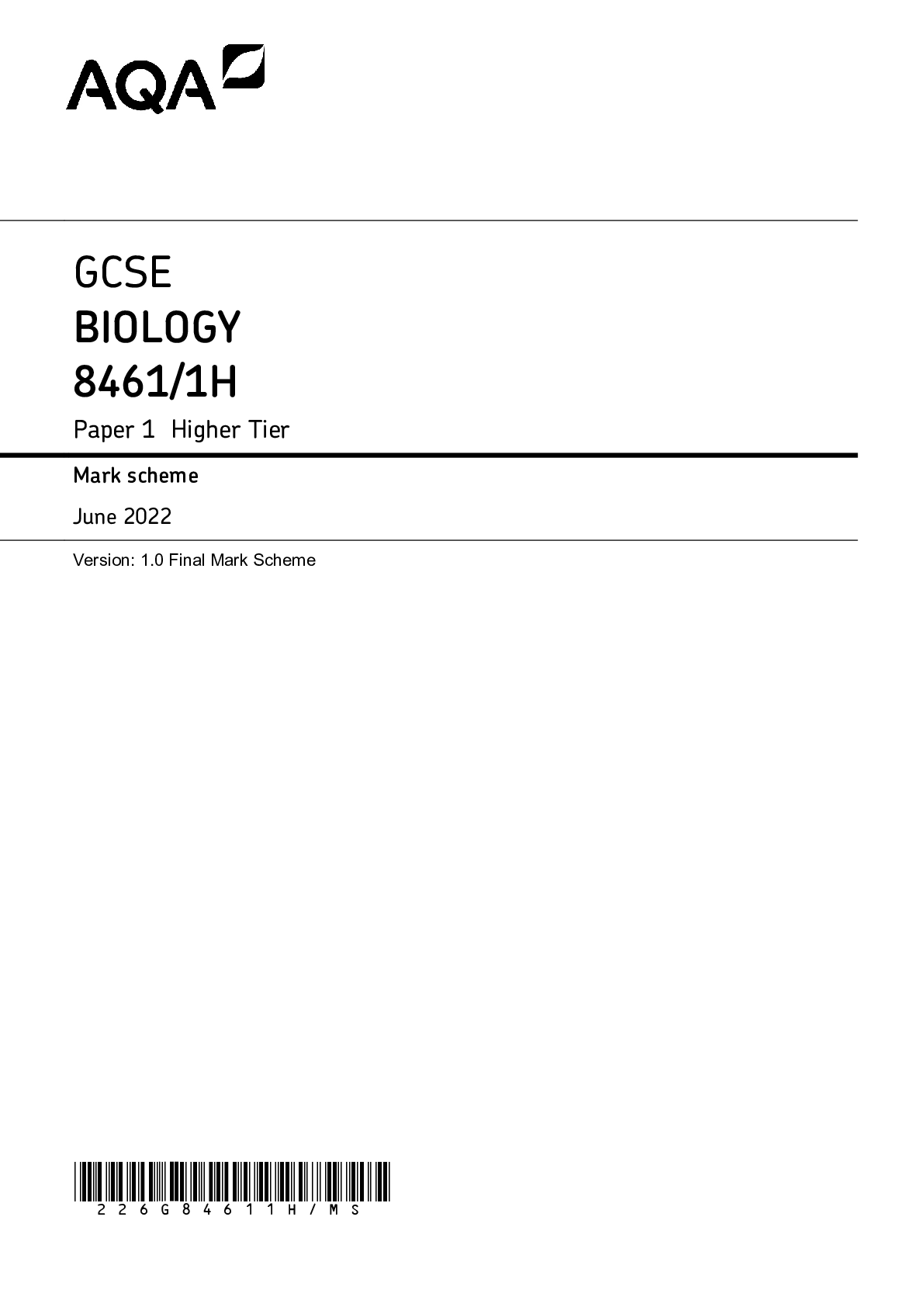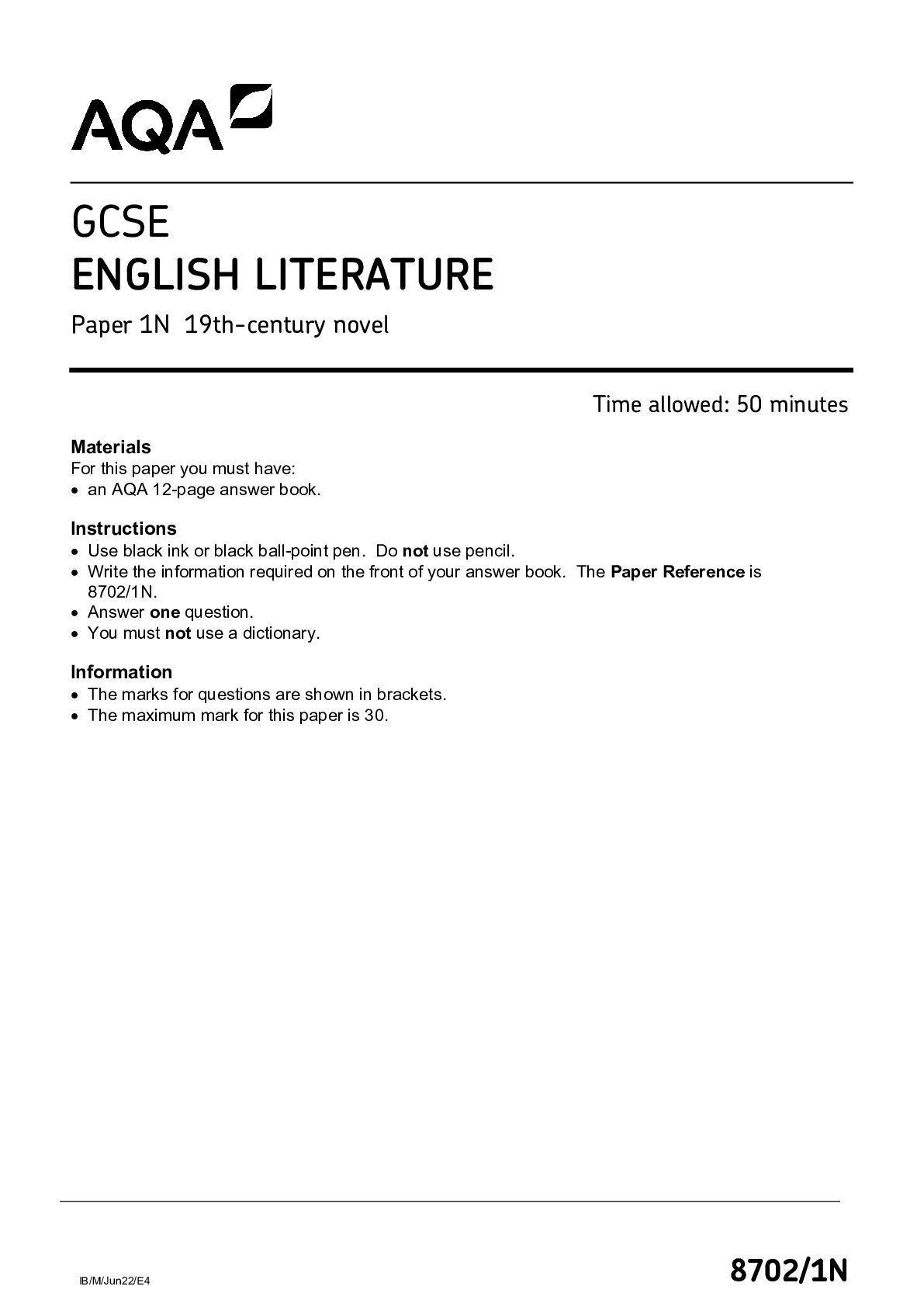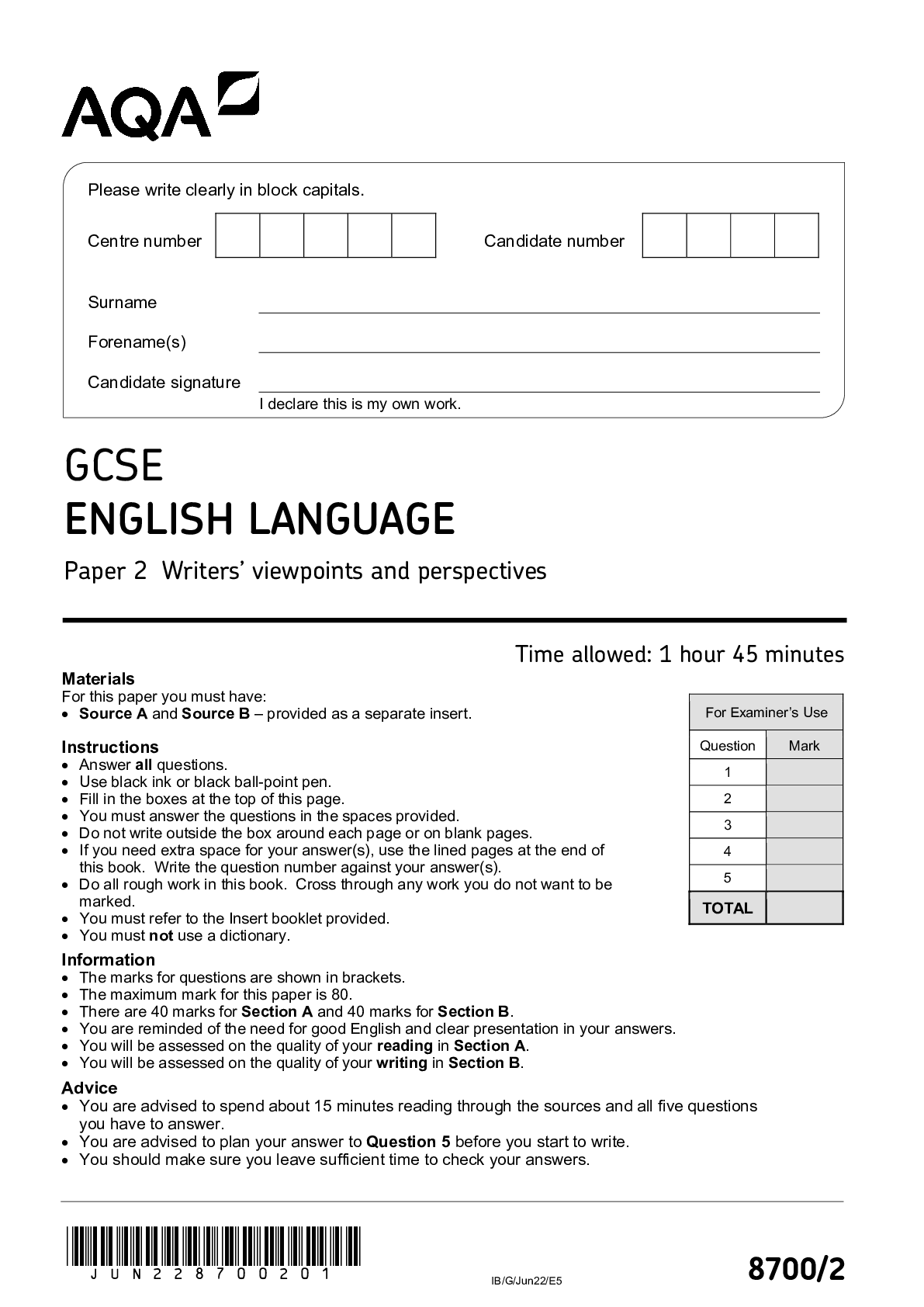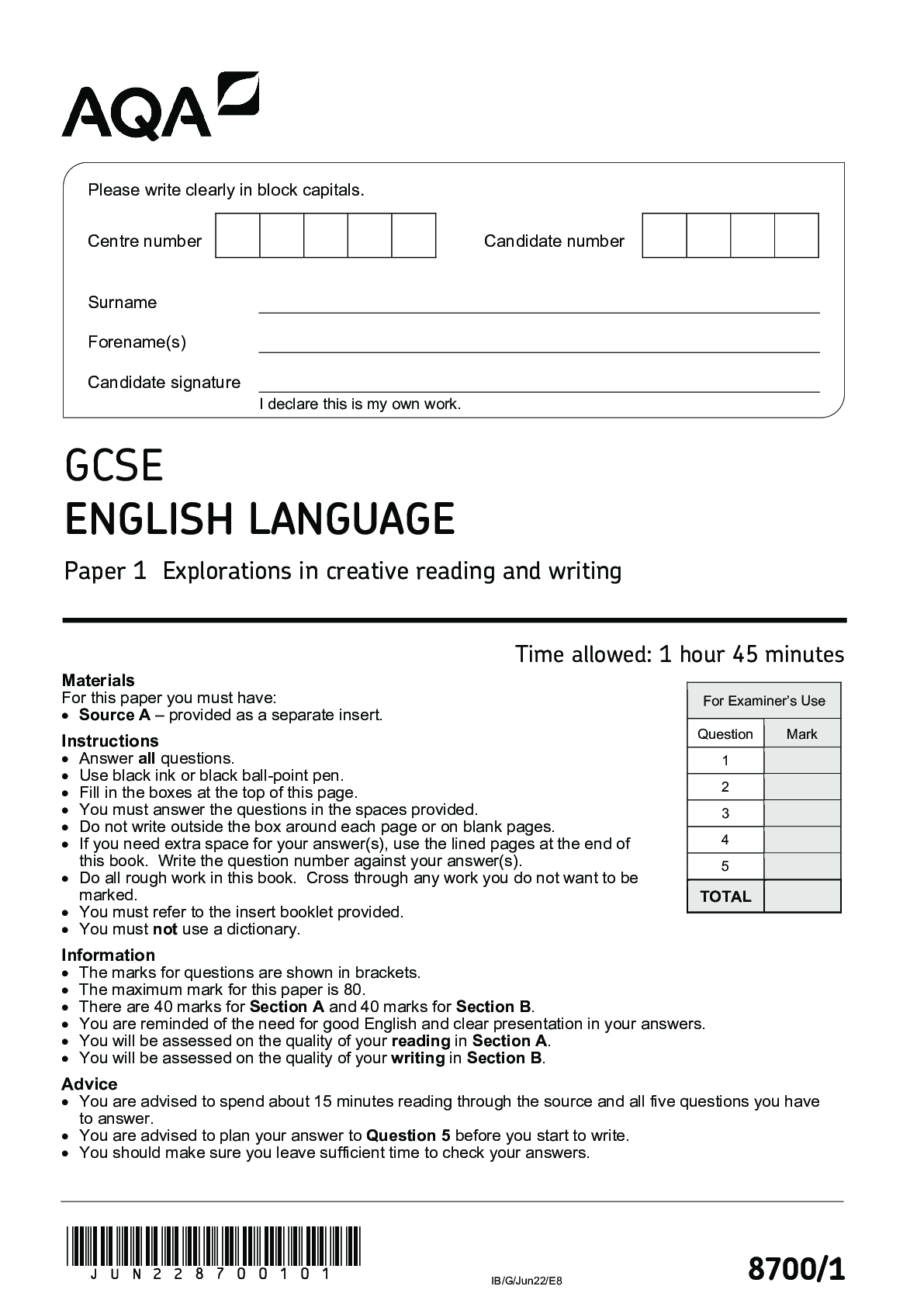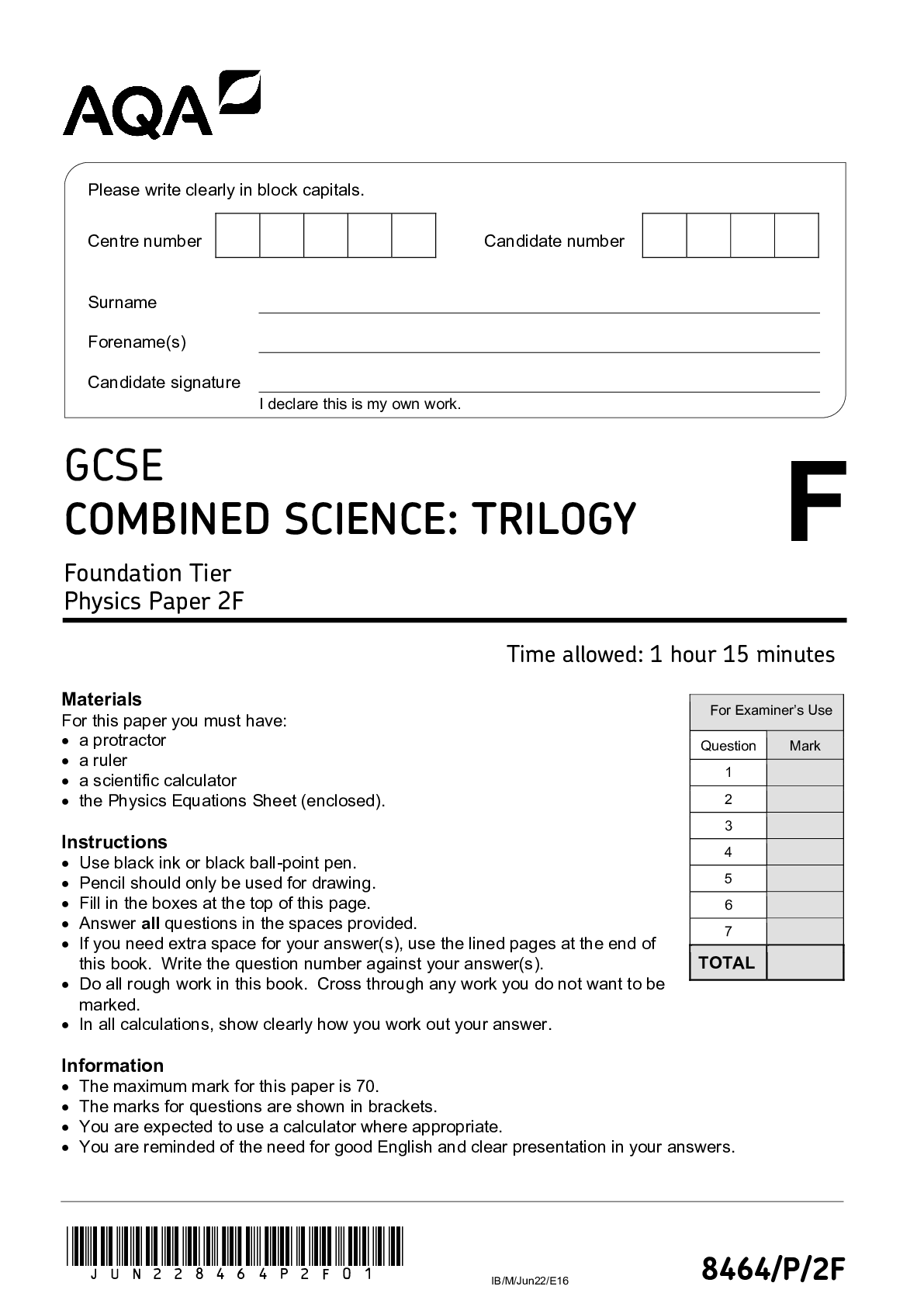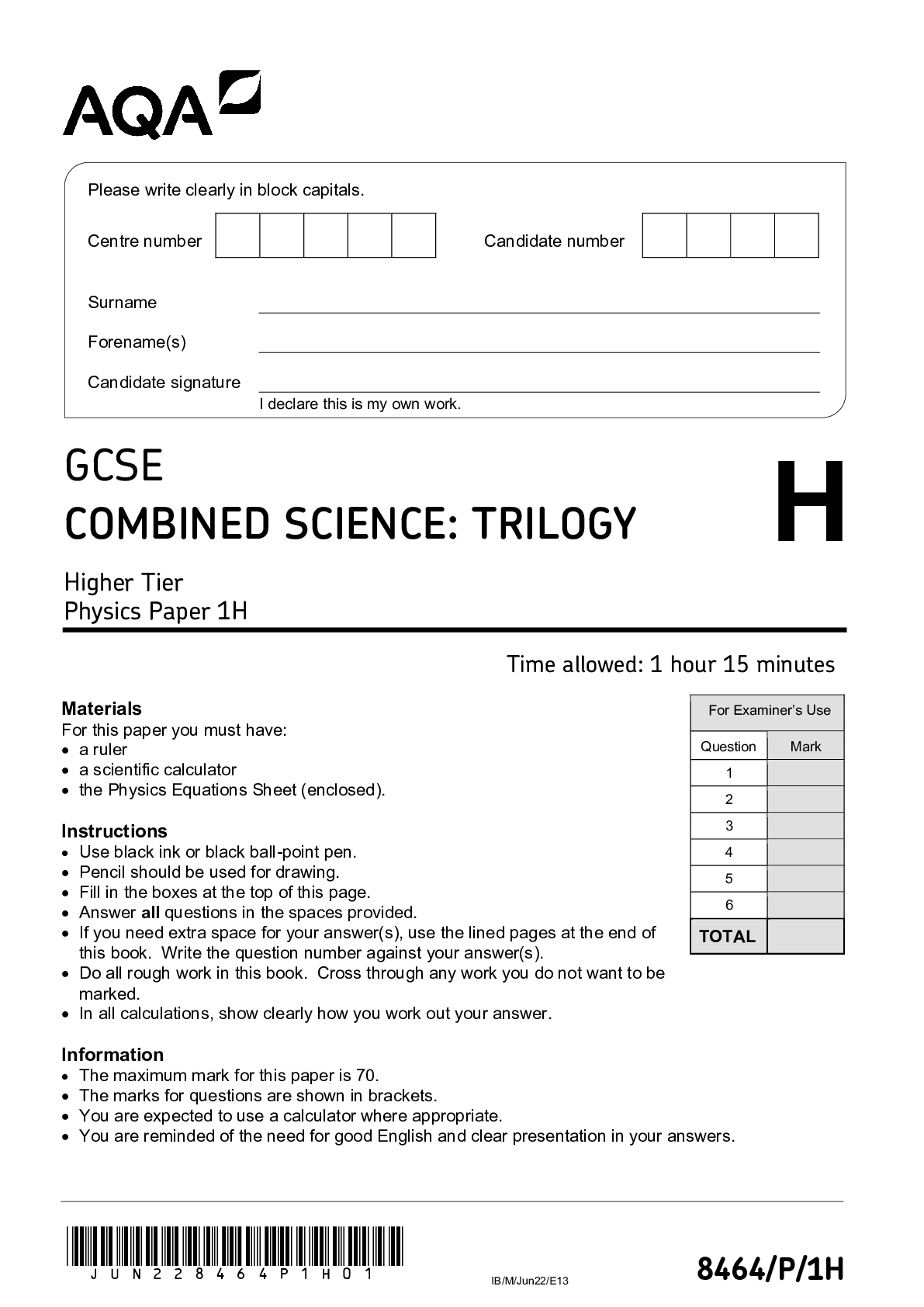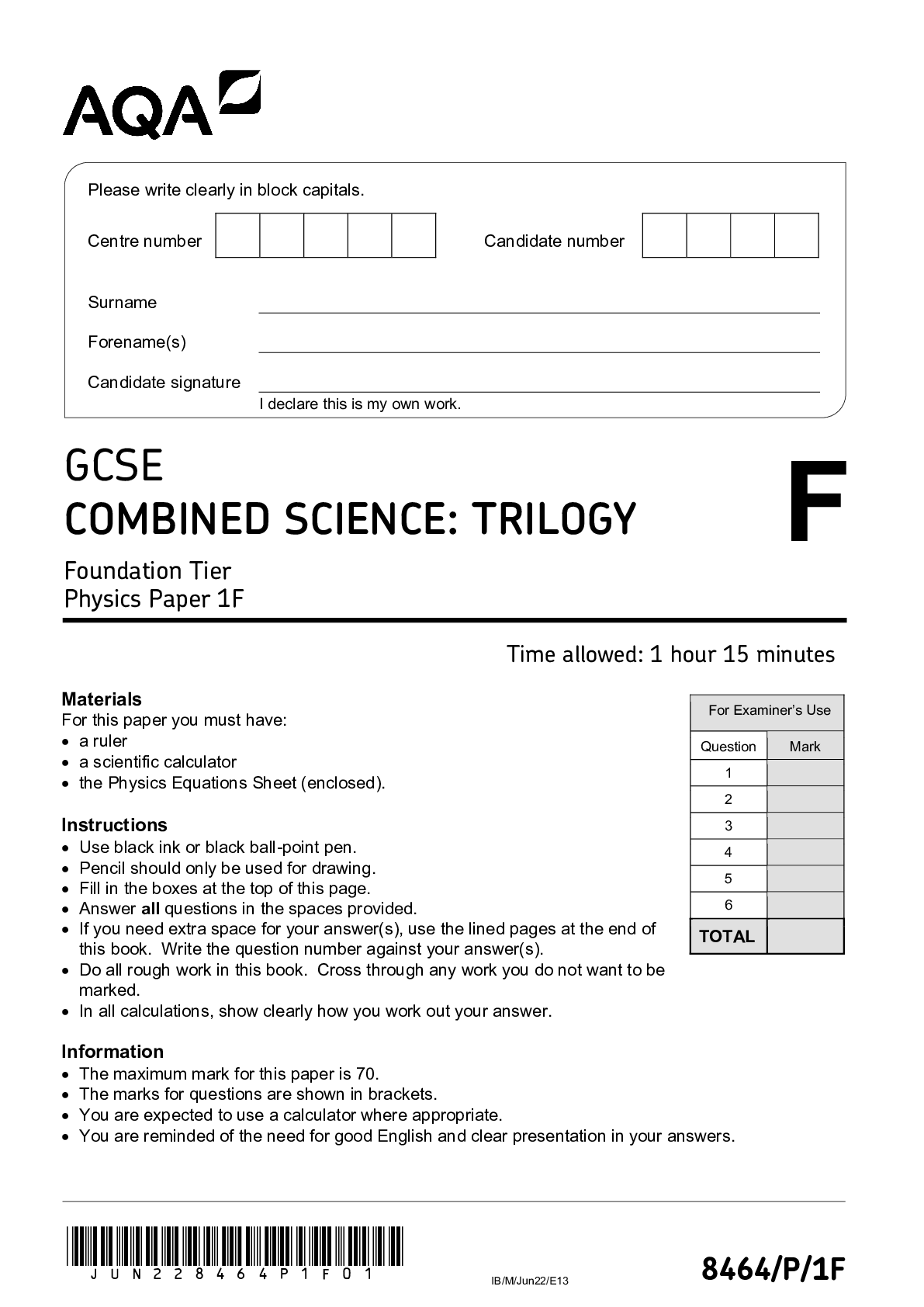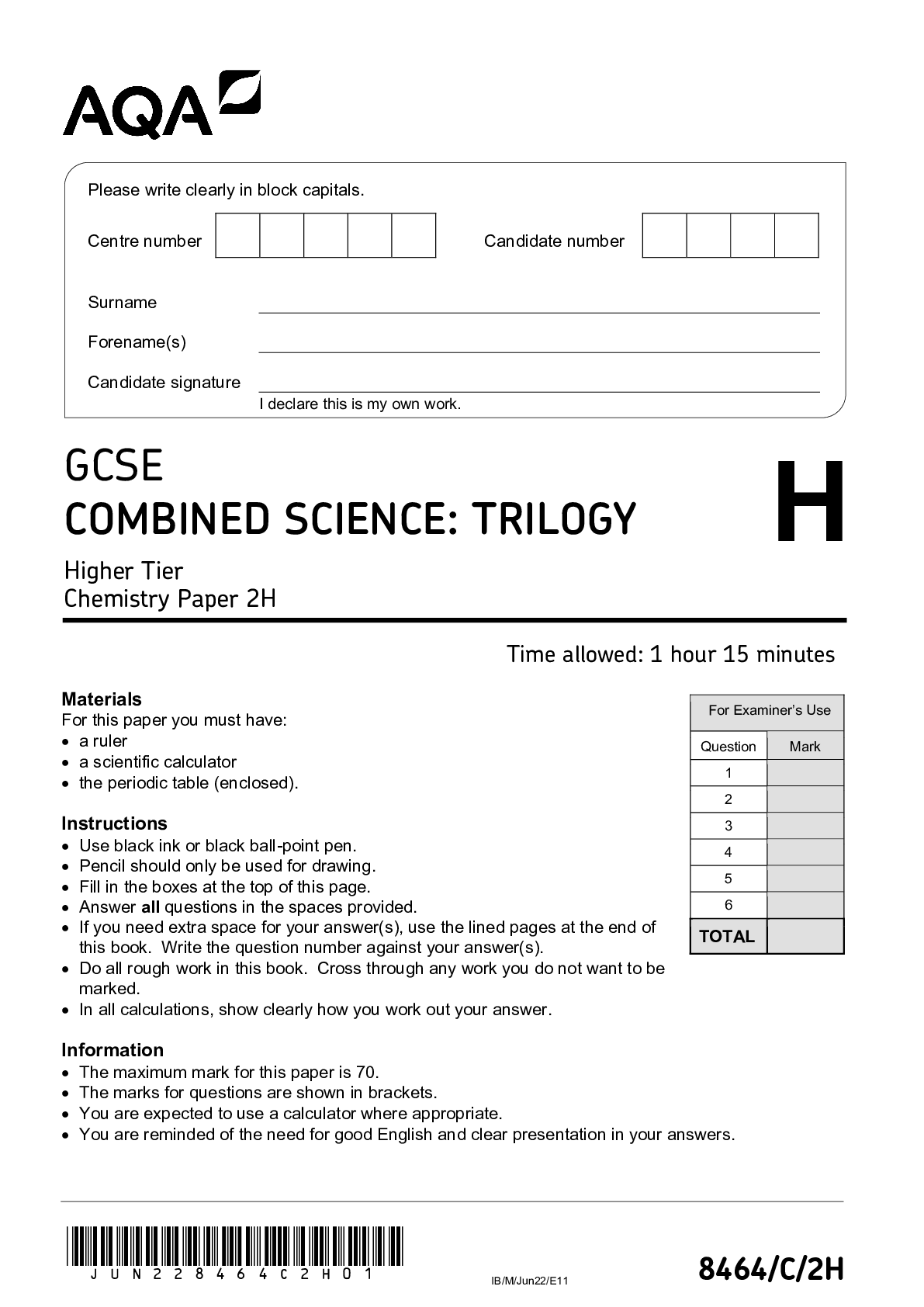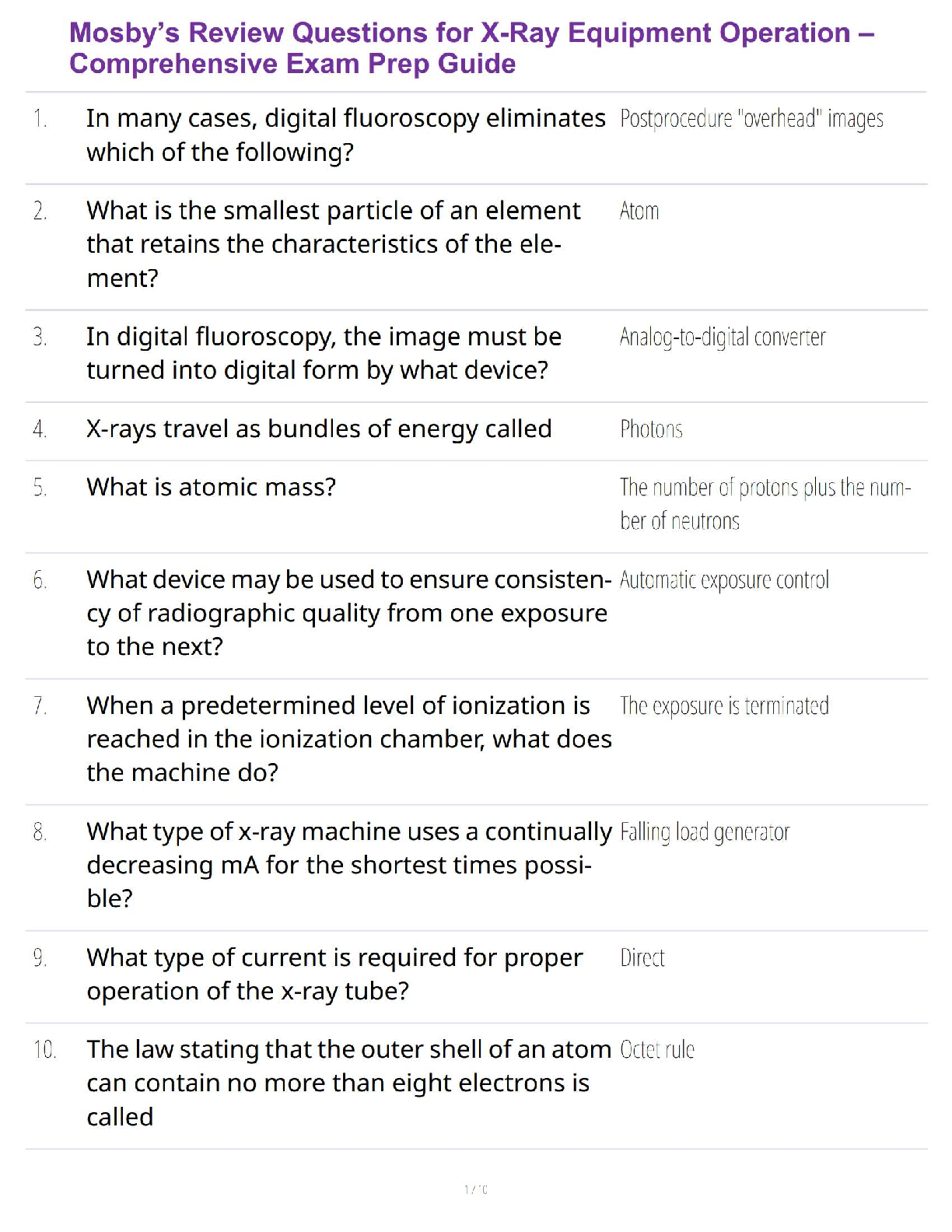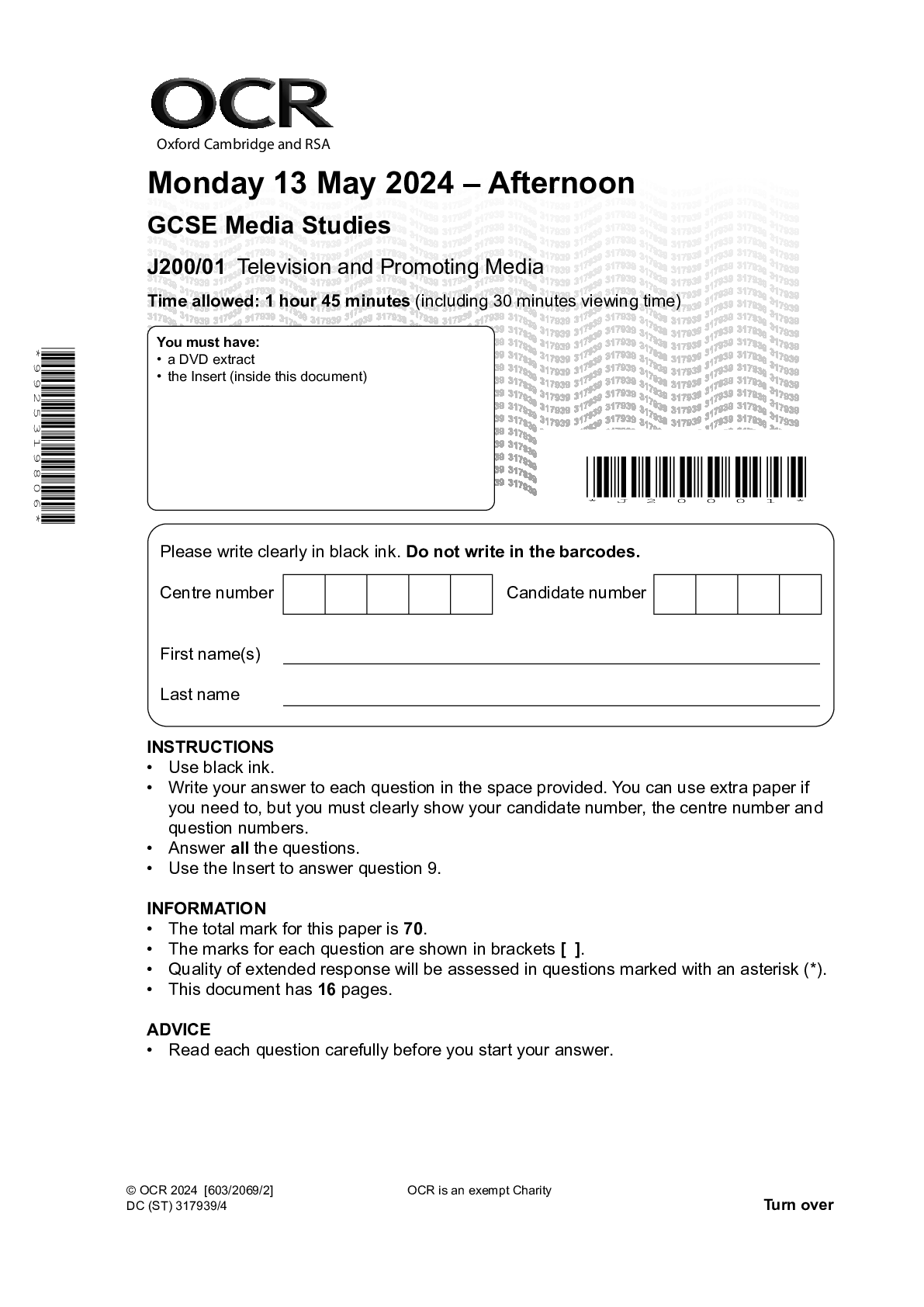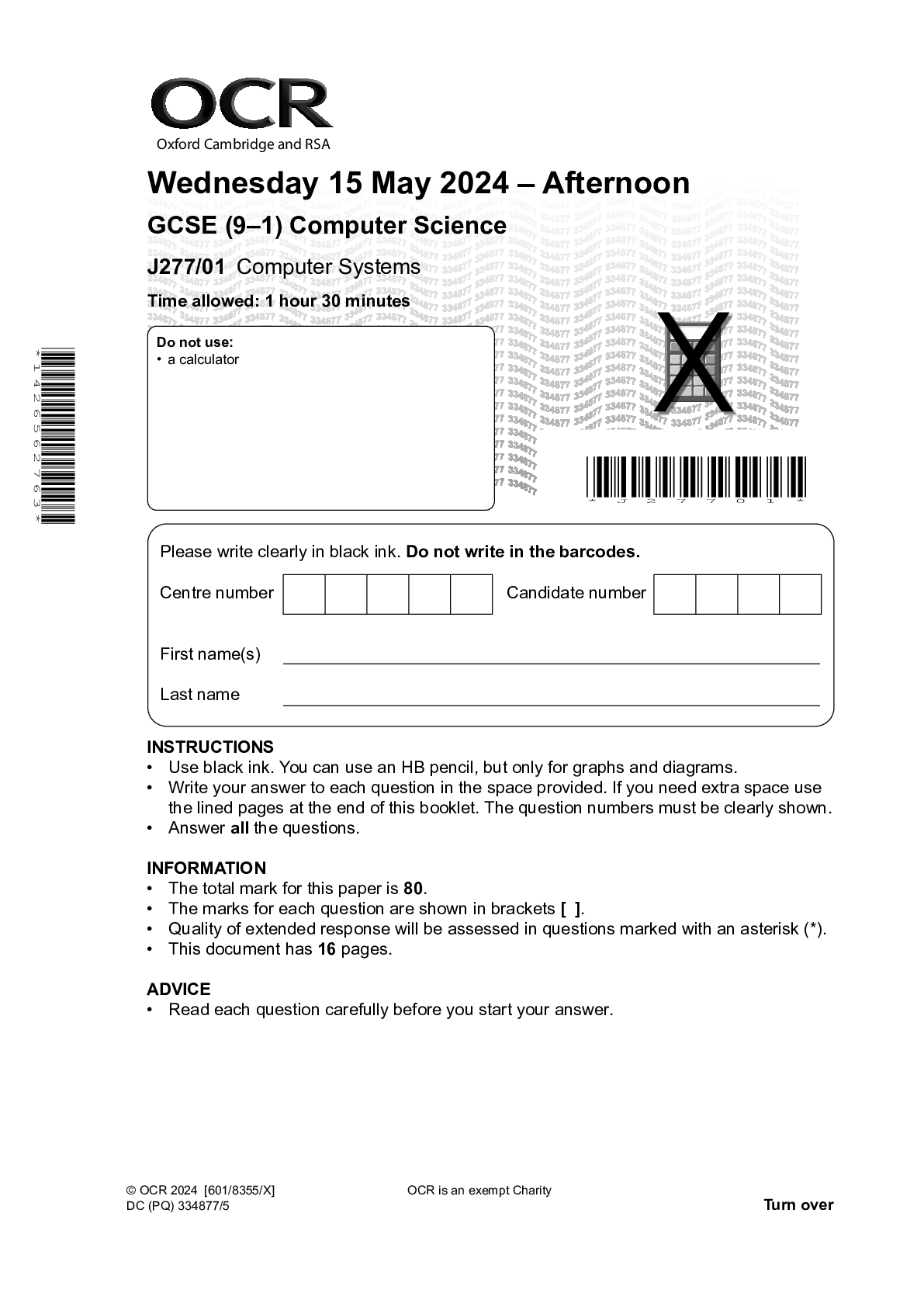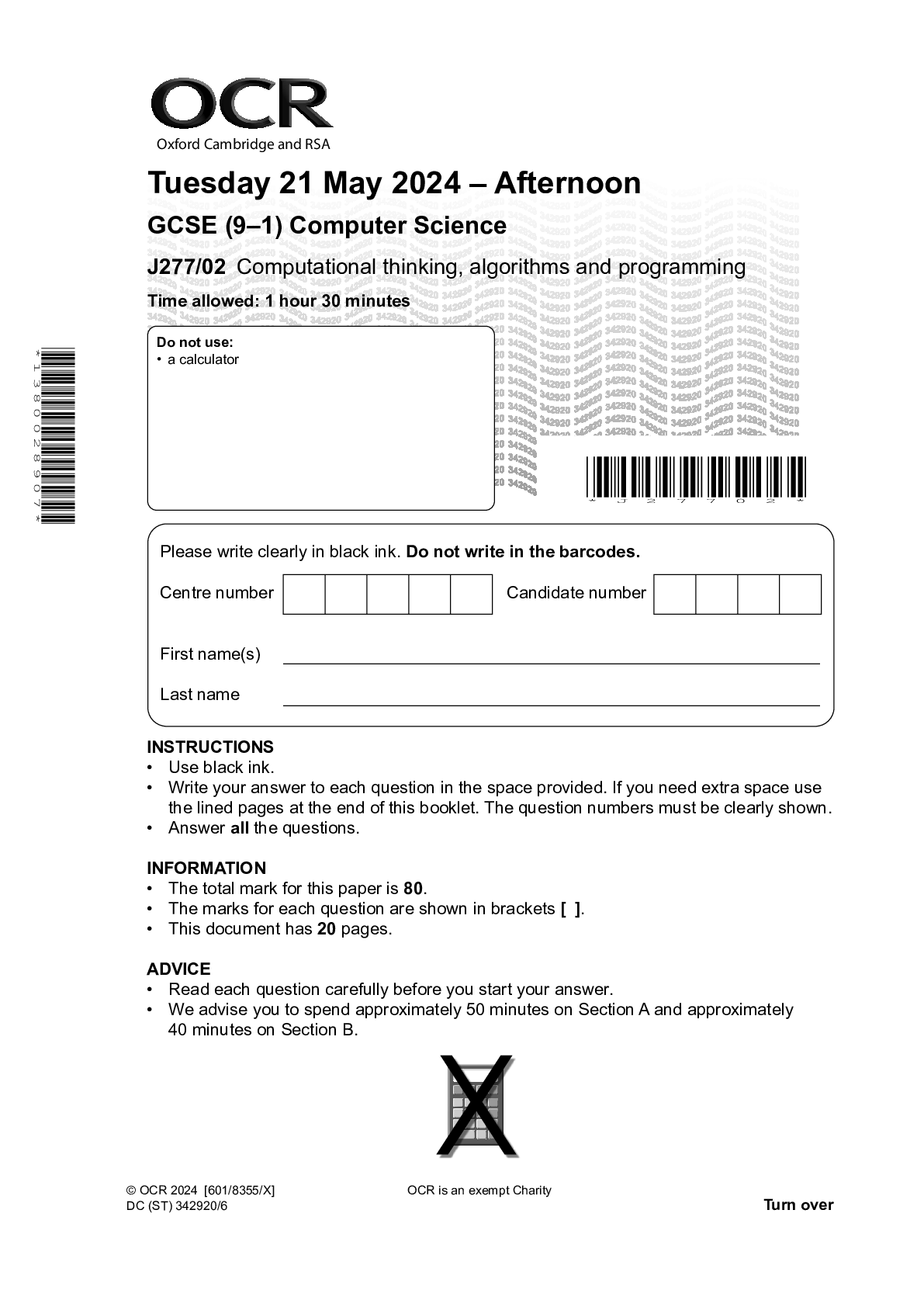Computer Science > QUESTION PAPER (QP) > Mark Scheme (Results) June 2022 Pearson Edexcel GCSE In Computer Science (1CP2/01) Paper 1: Princi (All)
Mark Scheme (Results) June 2022 Pearson Edexcel GCSE In Computer Science (1CP2/01) Paper 1: Principles of Computer Science Edexcel and BTEC Qualifications
Document Content and Description Below
Mark Scheme (Results) June 2022 Pearson Edexcel GCSE In Computer Science (1CP2/01) Paper 1: Principles of Computer Science Edexcel and BTEC Qualifications Edexcel and BTEC qualifications are a ... warded by Pearson, the UK’s largest awarding body. We provide a wide range of qualifications including academic, vocational, occupational and specific programmes for employers. For further information visit our qualifications websites at www.edexcel.com or www.btec.co.uk. Alternatively, you can get in touch with us using the details on our contact us page at www.edexcel.com/contactus. Pearson: helping people progress, everywhere Pearson aspires to be the world’s leading learning company. Our aim is to help everyone progress in their lives through education. We believe in every kind of learning, for all kinds of people, wherever they are in the world. We’ve been involved in education for over 150 years, and by working across 70 countries, in 100 languages, we have built an international reputation for our commitment to high standards and raising achievement through innovation in education. Find out more about how we can help you and your students at: www.pearson.com/uk June 2022 Publications Code 1CP2_01_rms_20220825 All the material in this publication is copyright © Pearson Education Ltd 2022 General Marking Guidance • All candidates must receive the same treatment. Examiners must mark the first candidate in exactly the same way as they mark the last. • Mark schemes should be applied positively. Candidates must be rewarded for what they have shown they can do rather than penalised for omissions. • Examiners should mark according to the mark scheme not according to their perception of where the grade boundaries may lie. • There is no ceiling on achievement. All marks on the mark scheme should be used appropriately. • All the marks on the mark scheme are designed to be awarded. Examiners should always award full marks if deserved, i.e. if the answer matches the mark scheme. Examiners should also be prepared to award zero marks if the candidate’s response is not worthy of credit according to the mark scheme. • Where some judgement is required, mark schemes will provide the principles by which marks will be awarded and exemplification may be limited. • When examiners are in doubt regarding the application of the mark scheme to a candidate’s response, the team leader must be consulted. • Crossed out work should be marked UNLESS the candidate has replaced it with an alternative response. 4 1CP2-01 Question Number Answer Additional Guidance Mark 1(a)(i) Any two from: • Can share files/data • Can share applications/software • Can collaborate • Can share peripherals (printers, speakers) • Can share connectivity (Internet connection, hotspot) • Can access files from any computer / hot desk • Central control/management (security, software updates, backup, remote support, users, remote monitoring) • Allows communication (email, social media, video conferencing, online meeting, collaborative games) 2 Question Number Answer Additional Guidance Mark 1(a)(ii) A description such as: • A LAN covers a small (geographic) area / a WAN covers a large (geographic) area (2) • A LAN uses infrastructure owned by one company / a WAN uses third-party infrastructure (2) • A LAN connects individual devices / uses switches (1), whereas a WAN connects LANs / uses gateways (1) Do not accept ‘smaller/larger’ in reference to the physical size of the network. 2 5 1CP2-01 Question Number Answer Additional Guidance Mark 1(a)(iii) B 17 080 000 A 17 080 is not correct because it is 17.08 multiplied by 1000 C 17 080 000 000 is not correct because it is 17.08 multiplied by 10003 D 17 080 000 000 000 is not correct because it is 17.08 multiplied by 10004 17 080 000 is 17.08 multiplied by 10002 1 Question Number Answer Additional Guidance Mark 1(a)(iv) The delay/amount of time between data/signal being sent and it being received Do not accept reference to delay/lag on its own. 1 Question Number Answer Additional Guidance Mark 1(b)i Clerical Any one from: • IP (address) • MAC (address) 1 Question Number Answer Additional Guidance Mark 1(b)ii A Data being sent B is not correct because it is located in the header C is not correct because it is located in the header D is not correct because it is not located in a packet 1 6 1CP2-01 Question Number Answer Additional Guidance Mark 1(c) A description to include two from: • Monitors/checks traffic (1) using a set of rules / list of authorised/unauthorised computers/addresses/protocols (1) to decide if data is allowed into or out of the network (1) 2 Question Number Answer Additional Guidance Mark 1(d) Clerical Any one from: • POP3 • IMAP • SMTP Accept POP 1 Question Number Answer Additional Guidance Mark 1(e) A linked explanation such as: • All communication could fail (1) because/if the central device fails (1) • It can be difficult/expensive to set up (1) because each device needs a cable to connect to the central device (1) • The number of devices that can be connected is limited (1) because the central device supports a fixed number of connections (1) For ‘central device’: • Accept ‘router’ or ‘hub’ (as a term to refer to a device that contains a switch). • Accept ‘switch’ (as this is the correct term to refer to the central device) • Do not accept ‘server’ 2 7 1CP2-01 Question Number Answer Additional Guidance Mark 2(a)i Any one from: • To represent an instruction/command • To make an instruction/command easy to read/write/learn/remember/understand • An instruction in a set of instructions Accept generic definitions of mnemonic such as: ‘To shorten a piece of information so it is easy to remember.’ 1 Question Number Answer Additional Guidance Mark 2(a)ii Clerical Assembly language 1 Question Number Answer Additional Guidance Mark 2(a)iii A linked description such as: • They are microprocessor/CPU/machine specific (1) so they can manipulate the hardware directly (1) • They can be highly optimised (1) to make efficient use of the hardware/execute more quickly/use minimal memory (1) • Each line of code (1) is one instruction only (1) Award responses that refer to machine code as a low level language, such as: • Machine code is written in binary (1) so instructions can be processed directly by the CPU / do not need to be translated (1) Award one mark for: • Machine code does not need to be translated (1) Accept: (Assembly language) instructions are assembled (1) to machine code (1) 2 8 1CP2-01 Question Number Answer Additional Guidance Mark 2(a)iv Clerical Interpreter 1 Question Number Answer Additional Guidance Mark 2(b) • Data • Instructions 2 Question Number Answer Additional Guidance Mark 2(c)i A description to include two from: A laser heats/burns (areas of a disk) (1), which creates lands/pits (1) representing binary / 1s and 0s (1) 2 Question Number Answer Additional Guidance Mark 2(c)ii Clerical Solid state / flash Accept ‘SSD’ for solid state 1 Question Number Answer Additional Guidance Mark 2(d) Any two from: • Limited processing resources • Low power consumption • Simple/robust operating system • Low cost per unit • Smaller in size • Less storage • Limited user interface Do not accept: ‘Carries out a specific task’: This is the opposite of ‘general purpose’, which is given in the question. 2 9 1CP2-01 Question Number Answer Additional Guidance Mark 2(e) Clerical A Reduces data transfer times C Reduces required storage space B is not correct because parts of a compressed file can still be written to several different places on a disk D is not correct as compression does not make data more secure like encryption does E is not correct because error detection/correction mechanism are still needed in network packets 2 Question Number Answer Additional Guidance Mark 2(f) Any two from: • Programming language specific vulnerabilities (directly manipulating memory) • Security (vulnerability) • Weak design • Insufficient testing • Bad programming practices (not following standards, using unvalidated 3rd party libraries) • Inadequate validation (that fails to prevent incorrect/inappropriate data input) • Inadequate authentication (that enables hackers to gain unauthorised access) • Sensitive data not encrypted 2 10 1CP2-01 Question Number Answer Additional Guidance Mark 2(g) A linked explanation such as: • Users can be added/deleted (1) so multiple people can use the same computer (1) • Edit user permissions (1) so only specific users can securely access their storage space (1) • Control the amount of resources/storage each user can access (1) so the limited storage on the machine can be shared (1) • Enforce user permissions (1) so only certain users are allowed to install programs / access certain files (1) 2 Question Number Answer Additional Guidance Mark 3(a)(i) Clerical 1 mark for each nibble: 0011(1) 1001(1) 2 Question Number Answer Additional Guidance Mark 3(a)(ii) Clerical 1 mark for each digit in the correct location: 2D 2 Question Number Answer Additional Guidance Mark 3(a)(iii) A linked description such as: • Flip all the bits (1) and add one (1) • Copy/keep all the 0s from the right/LSB, up to and including the first 1 (1), then flip the remaining bits (1) • Flip all the bits from the left/MSB (1) up to, but not including, the 1 nearest the right/LSB (1) 2 11 1CP2-01 Question Number Answer Additional Guidance Mark 3(a)(iv) A linked explanation such as: • There are not enough bits (1) to store the result (1) • An overflow occurs (1) because 1 + 1 = 0 with a 1 carry / because the result is more than 255 (1) 2 Question Number Answer Additional Guidance Mark 3(b) Clerical Lossy 1 Question Number Answer Additional Guidance Mark 3(c) A description to include two from: • A standard • For representing text/characters • Allows data to be interchangeable between computers (from different manufacturers) • Each character is mapped to a unique number/binary equivalent • ASCII (encoding) uses 7/8 bits • There are 128 unique characters (allow 256 for 128) Award a mark for an example of an ASCII character equivalence e.g. A = 65 as this can be awarded from mark point 4. (A = 010 [Show More]
Last updated: 2 years ago
Preview 1 out of 21 pages

Buy this document to get the full access instantly
Instant Download Access after purchase
Buy NowInstant download
We Accept:

Reviews( 0 )
$8.00
Can't find what you want? Try our AI powered Search
Document information
Connected school, study & course
About the document
Uploaded On
Apr 03, 2023
Number of pages
21
Written in
All
Additional information
This document has been written for:
Uploaded
Apr 03, 2023
Downloads
0
Views
166

